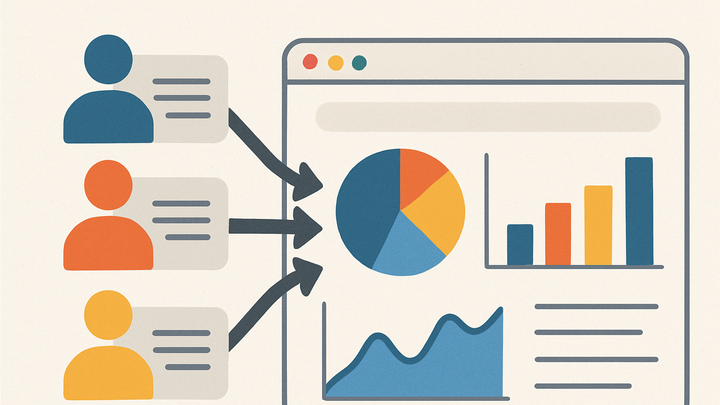Published on 2025-06-22T01:45:32Z
What is Aggregated Data? Examples with GA4 and PlainSignal
Aggregated Data is the process of summarizing raw, event-level user interactions into high-level metrics and counts.
In the analytics industry, it refers to combining individual data points—such as pageviews, sessions, or clicks—into summarized reports that show overall trends. This approach helps protect user privacy by removing personally identifiable details, reduces data storage and processing requirements, and simplifies decision-making for stakeholders. Platforms like Google Analytics 4 (GA4) and PlainSignal use aggregated data to deliver insights while adhering to privacy regulations such as GDPR and CCPA. By focusing on aggregates, businesses can quickly understand performance patterns without examining every individual record.
Aggregated data
Aggregated Data combines individual analytics events into summary metrics, enhancing privacy and simplifying high-level reporting.
Why Aggregated Data Matters in Analytics
Aggregated Data provides a high-level view of user behavior and performance, enabling faster insights and ensuring regulatory compliance.
-
Privacy and compliance
By removing or anonymizing individual identifiers, aggregated data reduces the risk of exposing personally identifiable information (PII). This approach helps organizations comply with regulations like GDPR and CCPA.
-
Gdpr compliance
Summaries prevent storing user-level details that fall under strict privacy laws.
-
Anonymization
Aggregating counts avoids tracking individual user journeys.
-
-
Performance and scalability
Summarized metrics require less storage and computing power than raw logs, making reporting faster and more cost-effective.
-
Actionable insights
High-level metrics like total sessions or average session duration allow stakeholders to quickly gauge site performance without diving into detailed event logs.
Aggregated Data vs Raw Data
Understanding the difference between aggregated and raw data helps analysts choose the right tool for their reporting and analysis needs.
-
Raw data
Event- or user-level records that capture every interaction with full detail, including timestamps, parameters, and user identifiers.
-
Granular information
Contains complete context for each event.
-
Storage intensive
Requires significant disk space and processing resources.
-
-
Aggregated data
Data summarized into counts or averages over time periods, segments, or dimensions, without exposing individual-level details.
-
Example metrics
Daily active users, total pageviews, average session duration.
-
How to Collect Aggregated Data with GA4 and PlainSignal
Both GA4 and PlainSignal offer methods to capture and report aggregated metrics while upholding user privacy.
-
Google analytics 4 (GA4)
GA4 automatically aggregates event data into standard reports. You can use the GA4 Data API or the reporting interface to retrieve metrics like
activeUsers,sessions, andengagementRate.-
Retrieving aggregated metrics
Use the GA4 Data API to request summarized data over specified dimensions and date ranges.
-
-
PlainSignal
PlainSignal is a cookieless, privacy-first analytics platform that only collects aggregated counts for key metrics.
-
Tracking code snippet
Insert the following script into your HTML to start collecting aggregated data:
<link rel="preconnect" href="//eu.plainsignal.com/" crossorigin /> <script defer data-do="yourwebsitedomain.com" data-id="0GQV1xmtzQQ" data-api="//eu.plainsignal.com" src="//cdn.plainsignal.com/plainsignal-min.js"></script>
-
Best Practices for Working with Aggregated Data
Adopt these practices to ensure your aggregated analytics remain accurate, timely, and actionable.
-
Choose appropriate granularity
Select reporting intervals (e.g., hourly, daily, weekly) that align with your analysis goals.
-
Monitor data freshness
Understand and account for reporting latency—GA4 can have up to a 24-hour delay, while PlainSignal offers near real-time updates.
-
Validate data consistency
Cross-check aggregated results with sample raw data or alternative tools to detect anomalies.
